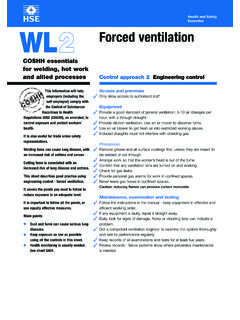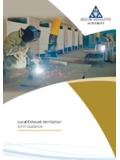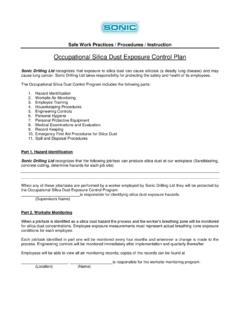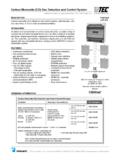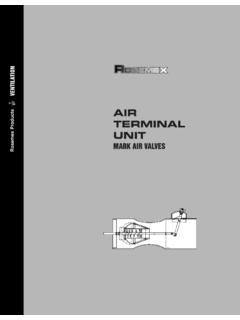Transcription of Department of Environmental Protection …
1 1 Department of Environmental Protection Promulgation of Revised Chapter 2 of Title 15 Of the Rules of the City of New York Concerning Performance Standards and Other engineering Criteria For Fossil Fuel Burning Boilers & Water Heaters The final rules include the following important changes and additions: Provisions are added that address natural gas boilers. References to fuel oil grades #4 and #6 are removed, as relating to the use of such fuels in new boilers, as the installation of new boilers using those fuels is no longer permitted.
2 The current combustion efficiency requirements for carbon dioxide have been deleted, as modern combustion efficiency analyzers now measure oxygen instead. The combustion efficiency requirement for oil-fired boilers is increased from 80 percent to 83 percent, and is established at 80 percent for natural gas-fired boilers. A requirement has been added for annual boiler tune-ups and combustion efficiency tests conducted by a qualified combustion tester using a calibrated combustion analyzer. The test results must be submitted with the application to renew the certificate of operation.
3 The equipment approval process has been changed to allow professional engineers to certify equipment that is not on DEP s Accepted Equipment list, provided the equipment meets required criteria. Additionally, equipment that is listed by Underwriters Laboratory, the Canadian Standards Association, or ETL is also acceptable. Unlisted or custom equipment will require certification by a professional engineer. Provisions that address condensing boilers are added. Provisions to allow for variances are added. Specific design requirements, such as heat release, combustion chamber, furnace volume, and oil handling, are deleted.
4 Chimney radial distances have been updated for new chimneys to conform to the requirements set forth in the Mechanical Code and Fuel Gas Code. 2 Chapter 2. engineering Criteria for Fossil Fuel Burning Boilers & Water Heaters 2-01 Introduction and Applicability. All owners of fossil fuel burning boilers and water heaters that require a certificate of operation under the New York City Air Pollution Control Code, as codified in Chapter 1 of Title 15 of the New York City Administrative Code, are subject to these rules.
5 In order for a work permit to be issued an application must be filed, accompanied by plans and any additional information. The application will enable the Department to evaluate the design of equipment installation for compliance with the specification requirements described in section 2-11 of this chapter. Upon issuance of a work permit, the equipment shall be installed and adjusted to meet the performance requirements specified in section 2-08 of this chapter. 2-02 Definitions. (1) AP-42. "AP-42" means the United States Environmental Protection Agency publication AP-42, Compilation of Air Pollutant Emission Factors, Volume I: Stationary Point and Area Sources (fifth edition, 1995).
6 (2) ASHRAE. ASHRAE means the American Society of Heating, Refrigerating, and Air Conditioning Engineers. (3) ASTM International. ASTM International is formerly known as the American Society for Testing and Materials. (4) Barometric damper. Barometric damper means a device which consists of a damper counter-weighted and set such that boiler room barometric pressure will cause the damper to open or close to check variations in chimney draft and thereby maintain a constant draft directly upstream of the barometric draft regulator location.
7 (5) Biogas. "Biogas" means a mixture of methane and carbon dioxide produced by the anaerobic digestion of organic matter used as a fuel; includes landfill gas and digester gas. (6) Boiler. "Boiler" means equipment that is used to heat water or any other transfer medium for the purpose of generating hot water and/or steam. The hot water and/or steam generated by a boiler may be used for heating, processing, or generating power for other purposes, including but not limited to, cooking and sanitation. (7) British thermal unit.
8 British thermal unit (Btu) means the amount of energy needed to heat one pound of water by one degree Fahrenheit. (9) Burner. "Burner" means a device for the final conveyance of the fuel, or a mixture of fuel and air, to the combustion zone. (9) Calibration test. Calibration test means to calibrate the qualified combustion analyzer in accordance with the manufacturer s specifications. (10) Certificate of operation. "Certificate of operation" means a document issued by the Department authorizing the operation of a specific piece of equipment or apparatus that may emit an air contaminant.
9 (11) Chimney. Chimney means a primarily vertical structure containing one or more flues, for the purpose of carrying gaseous products of combustion and air from fuel-burning appliances to the outside atmosphere. 3 (12) Chimney diameter. Chimney diameter means for round chimneys, the diameter shall be taken as the actual inside diameter. Where the chimney is provided with a liner, its inside diameter is the chimney diameter. For rectangular chimneys, the equivalent diameter for equal friction and capacity shall be used based on the inside rectangular dimensions.
10 (13) Chimney height. Chimney height is the distance from the centerline of the entrance of the combustion gases into the chimney to the top of the chimney. (14) Combustion efficiency. Combustion efficiency means a measurement of the burner s ability to burn fuel. It is the heat input minus the stack losses. (15) Combustion efficiency test. Combustion efficiency test means a test of steady state combustion efficiency carried out by a qualified combustion tester using a qualified combustion analyzer. (16) Condensing Boiler.










